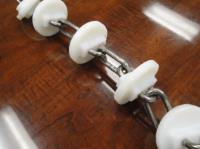 Add My Company
Add My Company
Sign In

Different applications need different drag chain conveyor types. We’re here to help make sure you choose the right option for your application. We’ve been in the bulk material handling industry for more than 45 years and have designed and sold all types of drag conveyors over the years.
Choosing the correct drag chain conveyor type means you’re not spending more money on a conveyor you may not need. It also means you’re getting a conveyor that can handle your product without concerns of mechanical failure or system downtime. Everything you need to know is right here.
DRAG CHAIN CONVEYOR TYPES
I want to take a second to define exactly what I’m talking about. The differences between structural drag chain conveyors (ultra heavy-duty) and tubular drag chain conveyors (heavy-duty) are easy to spot. From the exterior, you can see that structural drag chain conveyors are built with schedule 40 pipe. Tubular drag chain conveyors are often built with stainless steel tubes.
The differences are easy to spot inside the conveyor too. Structural conveyors have stainless steel or cast iron chains with UHMWPE or steel/iron discs. The non-structural conveyor has a stainless steel chain with molded on UHMWPE discs.
How drag chain conveyors are built determines what kind of materials can be passed through them.
DRAG CHAIN CONVEYOR TYPES: DIFFERENCES IN CONVEYABLE MATERIAL
The material you’re looking to convey is one of the biggest determining factors for what conveyor you need. This is a topic we’ve written about before when every type of conveyor is being considered. I’m just focusing on drag chains here. Any product a tubular drag chain can convey, a structural drag chain convey. That rule doesn’t apply going the other way.
Structural drag chain conveyors can handle virtually any type of bulk material but these aren’t recommended for hygienic applications. It’s worth noting that these conveyors run much slower than other types, so it is important to understand their maximum rate and capacity compared your desired rate & capacity (more on this below). These types of conveyors are much more expensive than the drag chain alternative.
Tubular drag chain conveyors aren’t as much of a workhorse, but they are effective when it comes to a variety of materials. Dry, cold, hot (up to 180˚F/82˚C), powders, and granules are ideal for the conveyors. Sludge, slurries, moist, and cohesive materials should typically be avoided. Another blog posts details what should and shouldn’t be conveyed in a chain drag conveyor.
DRAG CHAIN CONVEYOR TYPES: SPEED, CAPACITY, AND LENGTH
Structural drag chain conveyors can run up to 50 ft/min (15 m/min) with a capacity up to 10 ft3/min (0.28 m3/min). A conveyor’s maximum total length is up to 400 ft (120 m) and multiple conveyors can be linked together.
Tubular drag chain conveyors can run up to 100 ft/min (30 m/min) with a capacity up to 6.2 ft3/min (0.18 m3/min). The total length is up to 500 ft (152 m). These conveyors can also be daisy chained.
DRAG CHAIN CONVEYOR TYPES: CLEANABILITY
Cleanability is a topic that comes up whenever we work with a customer. It might be your number one priority depending on your application. So, I thought I’d address it here.
STRUCTURAL DRAG CHAIN CONVEYOR CLEANABILITY
These conveyors aren’t designed or recommended for hygienic/sanitary applications. They can be cleaned using a cleaning media in non-sanitary applications.
TUBULAR DRAG CHAIN CONVEYOR CLEANABILITY
This type of conveyor is ideal for hygienic applications with its crevice-free chain and disc assembly.
Sanitary Applications:
Food products are common applications requiring a very low microbial count.
The chain can be removed for cleaning and dried remotely.
Non-Sanitary Application:
The conveyors can be cleaned by dry scouring (running an abrasive product) or air purging.
Scavenged dust is directed out through a discharge outlet.
They can also be wet washed and drained.
The chain can be removed for cleaning and dried remotely.
DRAG CHAIN CONVEYOR TYPES: MAINTENANCE DIFFERENCES
Proper chain tensioning is crucial for any type of drag conveyor regardless of its construction. Be sure to ask the manufacturer about auto tensioning options.
USE A TEST LAB
Anyone with experience in the dry solids and powder processing industry can tell you what likely will or won’t work for an application. The only way to know for sure is to utilize a test lab. Spiroflow has test labs in the United States and the United Kingdom. I can tell you from experience that fine-tuning a piece of equipment is much easier in the testing phase than post installation.
For more information on Drag Chain Conveyor Types: How to Choose the Best talk to Spiroflow Ltd
Enquire Now
List your company on FindTheNeedle.
